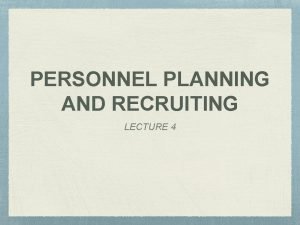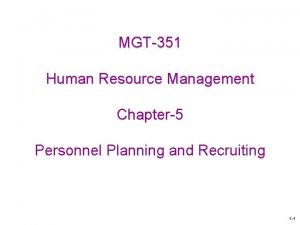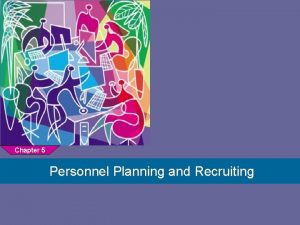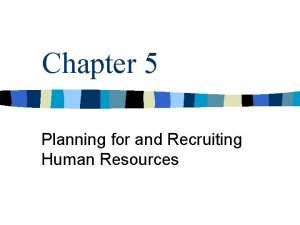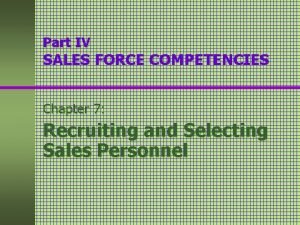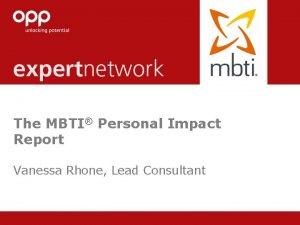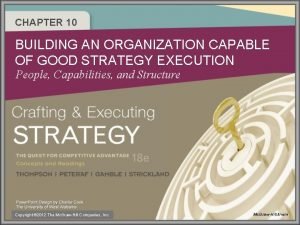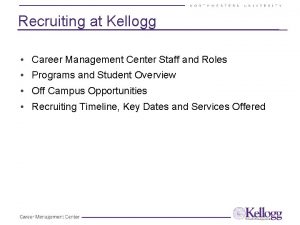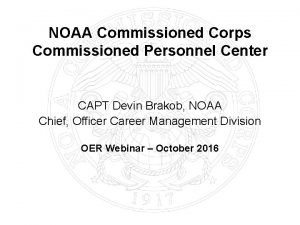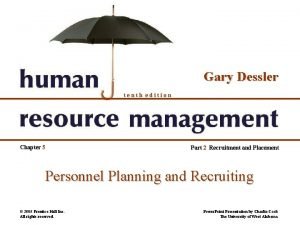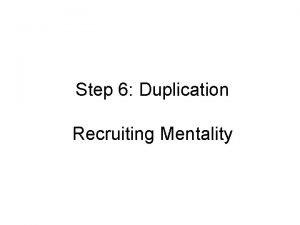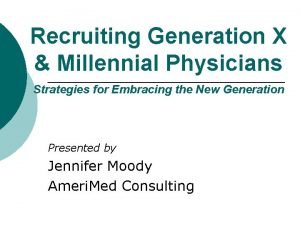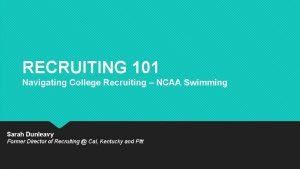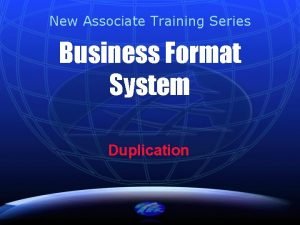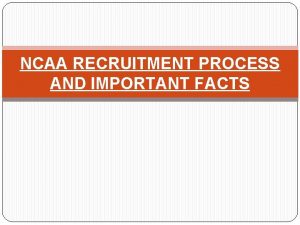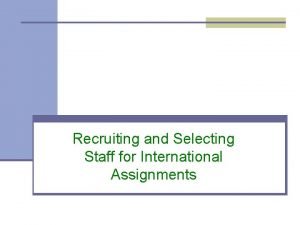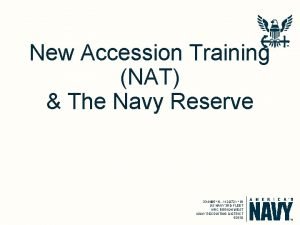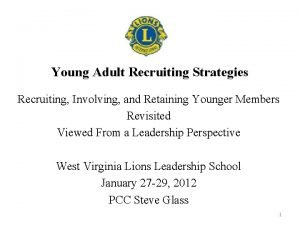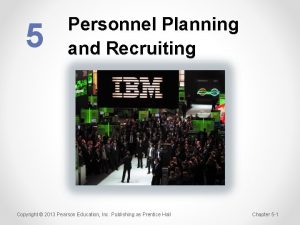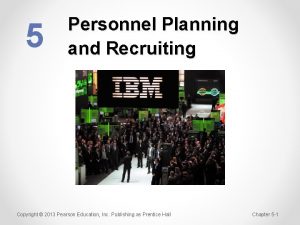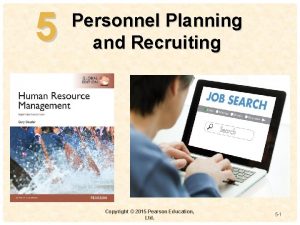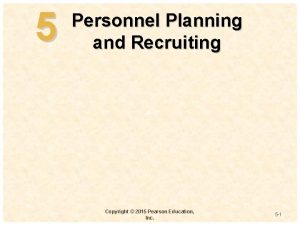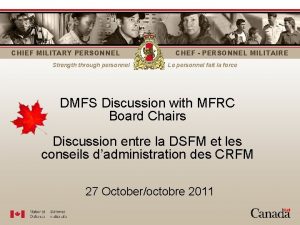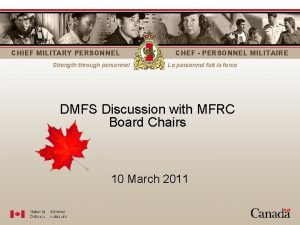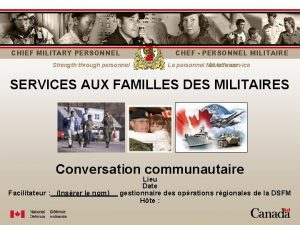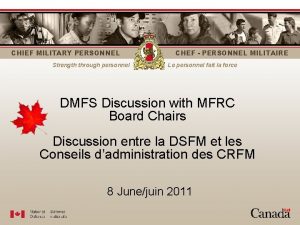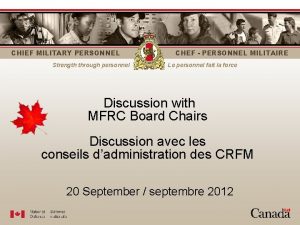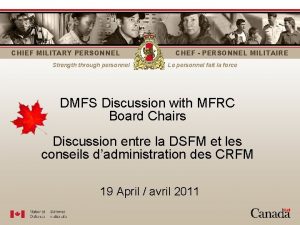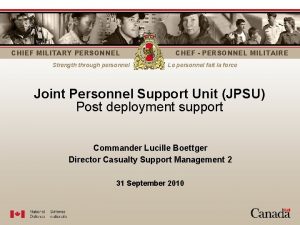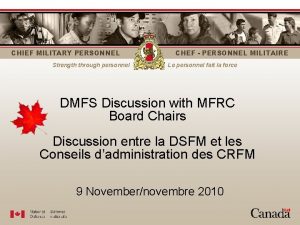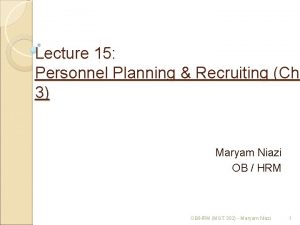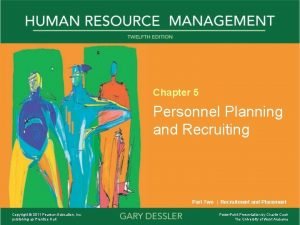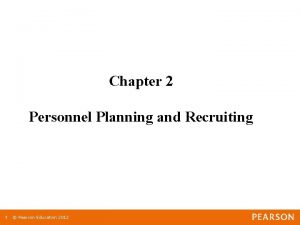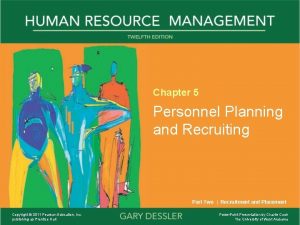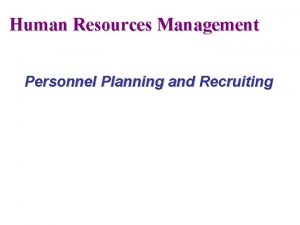Lecture 4 Personnel Planning and Recruiting Copyright 2013






























- Slides: 30

Lecture 4: Personnel Planning and Recruiting Copyright © 2013 Pearson Education, Inc. Publishing as Prentice Hall Chapter 5 -1

Human Resource Planning (Personnel Planning) Systematic process of: o. Matching the internal and external supply of candidates with job openings anticipated in the organization over a specific period of time Copyright © 2012 Pearson Education, Inc. publishing as Prentice Hall 4 -2

Human Resource Planning Process External Environment Internal Environment Strategic Planning Human Resource Planning Forecasting Human Resource Requirements Comparing Requirements and Availability Demand = Supply Surplus of Workers No Action Restricted Hiring, Reduced Hours, Early Retirement, Layoffs, Downsizing Forecasting Human Resource Availability Shortage of Workers Recruitment Selection Copyright © 2012 Pearson Education, 4 -3 Inc. publishing as

The Basic Elements of Human Resource Planning 3 -4

Requirements Forecast • Determining: o. Number o. Skills o. Location of employees that organization will need at future dates in order to meet goals Copyright © 2012 Pearson Education, Inc. publishing as Prentice Hall 4 -5

Availability Forecast • Determination of: o Whether firm will be able to secure employees with necessary skills o Sources from which to obtain employees Copyright © 2012 Pearson Education, Inc. publishing as Prentice Hall 4 -6

Recruitment • Process of attracting individuals: o On a timely basis o In sufficient numbers o With appropriate qualifications Copyright © 2012 Pearson Education, Inc. publishing as Prentice Hall 5 -7

Recruitment Planning: Administrative Issues • In-house vs. external recruitment agency o Many companies do recruiting in-house • Recommended approach for large companies o Smaller companies may rely on external recruitment agencies • Centralized vs. decentralized recruitment 5 -8

External Environment of Recruitment • Labor market conditions • Active or passive job seekers • Legal considerations • Corporate image Copyright © 2012 Pearson Education, Inc. publishing as Prentice Hall 5 -9

Labor Markets: Other Issues • Labor shortages and surpluses o “Tight” labor markets-demand exceeds supply, so labor shortages o “Loose” labor markets-supply exceeds demand, so labor surpluses 3 -10

Shortage of Workers Forecasted • • Innovative recruiting Compensation incentives Training programs Modified selection standards Copyright © 2012 Pearson Education, Inc. publishing as Prentice Hall 4 -11

Surplus of Employees When a comparison of requirements and availability indicates that a worker surplus will result, most companies look to alternatives to layoffs, but downsizing may ultimately be required. Copyright © 2012 Pearson Education, Inc. publishing as Prentice Hall 4 -12

• Active or Passive Job Seekers Active job seekers: Committed to finding another job • Passive candidates: Typically employed, satisfied with their employer, and content in their current role • Recruitment methods often differ Copyright © 2012 Pearson Education, Inc. publishing as Prentice Hall 5 -13

Recruitment Sources and Methods • Recruitment sources: Places where qualified individuals are found • Recruitment methods: Means by which potential employees can be attracted to firm Copyright © 2012 Pearson Education, Inc. publishing as Prentice Hall 5 -14

Internal Versus External Staffing 3 -15

Internal Recruitment Methods • • Human resource databases Job postings Internet/Intranet Company’s online newsletter Copyright © 2012 Pearson Education, Inc. publishing as Prentice Hall 5 -16

Employee Referrals • Effective way workers find a job • Referrals better qualified and stay on job longer • Recruit new hires through employee-referral incentive programs Copyright © 2012 Pearson Education, Inc. publishing as Prentice Hall 5 -17

External Recruitment Sources • • • High schools and vocational schools Colleges and universities Competitors in the labor market Former employees Self-employed workers Copyright © 2012 Pearson Education, Inc. publishing as Prentice Hall 5 -18

Competitors in the Labor Market • Used when relevant experience is needed. • Smaller firms look for employees trained by larger organizations. • Poaching: Actively recruiting employees from competitors. Copyright © 2012 Pearson Education, Inc. publishing as Prentice Hall 5 -19

Online Recruitment • Biggest change in organizations recruit way that • Revolutionized the way companies recruit and job-seekers find jobs 5 -20 Copyright © 2012 Pearson Education, Inc. publishing as

Corporate Career Website • Accessible from company homepage • Lists company positions available • Provides way for applicants to apply for specific jobs Copyright © 2012 Pearson Education, Inc. publishing as Prentice Hall 5 -21

Social Network Recruiting • Networking is one of the best recruiting tools. • Websites have been developed to utilize social network recruiting. o Twitter, Facebook, and Linked. In • Excellent in candidates. search Copyright © 2012 Pearson Education, Inc. publishing as Prentice Hall 5 -22 for passive

Traditional External Recruitment Methods • Media • Professional advertising associations • Employment • Sign-on bonuses agencies • Job fairs • Internships • Executive search firms Copyright © 2012 Pearson Education, Inc. publishing as Prentice Hall 5 -23

Job Fairs • Attract large number of applicants to one location • Opportunity to meet large number of candidates in short time Copyright © 2012 Pearson Education, Inc. publishing as Prentice Hall 5 -24

Internships • Places student in a temporary job • No obligation to confirm the position • Part-time job during school year • Students bridge gap from theory to practice Copyright © 2012 Pearson Education, Inc. publishing as Prentice Hall 5 -25

Headhunters/Employment Agencies • Often best known for recruiting whitecollar employees • Used for virtually every kind of position • Not paid until a person is placed Copyright © 2012 Pearson Education, Inc. publishing as Prentice Hall 5 -26

Temp Agencies and Alternative Staffing • Pros and cons • What supervisors should know about temporary employees’ concerns • Legal guidelines Copyright © 2013 Pearson Education, Inc. Publishing as Prentice Hall Chapter 5 -27

Sign-On Bonuses • Used where severe shortages of highly skilled workers exist • Amounts vary dramatically 5 -28 Copyright © 2012 Pearson Education, Inc. publishing as

Outsourcing • Advantages • Disadvantages • Special issues o Employer concerns regarding working conditions o Loss of control over quality o Offshoring 3 -29

Metrics for Evaluating Recruiting Methods • Quality • Cost • Impact on HR Outcomes o Employee satisfaction o Job performance o Retention 5 -30
 Personnel planning and recruitment
Personnel planning and recruitment Chapter 5 personnel planning and recruiting
Chapter 5 personnel planning and recruiting Forecasting the supply of outside candidates
Forecasting the supply of outside candidates Chapter 5 planning for and recruiting human resources
Chapter 5 planning for and recruiting human resources Recruiting and selecting sales personnel
Recruiting and selecting sales personnel Mbti personal impact report
Mbti personal impact report 01:640:244 lecture notes - lecture 15: plat, idah, farad
01:640:244 lecture notes - lecture 15: plat, idah, farad Project planning and management lecture notes ppt
Project planning and management lecture notes ppt The process of recruiting and retaining capable employees
The process of recruiting and retaining capable employees Driver recruiting techniques
Driver recruiting techniques Land use planning '' lecture notes
Land use planning '' lecture notes Land economics lecture notes
Land economics lecture notes Land use planning '' lecture notes
Land use planning '' lecture notes Supply chain management and total quality management ppt
Supply chain management and total quality management ppt Script for recruiter
Script for recruiter Kellogg recruiting
Kellogg recruiting Noaa corps recruiting
Noaa corps recruiting Recruiting yield pyramid
Recruiting yield pyramid Avature recruiting
Avature recruiting Recruiting mentality
Recruiting mentality Recruiting millennial physicians
Recruiting millennial physicians Sarah dunleavy swimming
Sarah dunleavy swimming Magic of compound recruiting
Magic of compound recruiting Ncaa recruiting facts
Ncaa recruiting facts Recruiting yield pyramid
Recruiting yield pyramid Indirect cost of expatriate failure
Indirect cost of expatriate failure Fraus omnia vitiate
Fraus omnia vitiate Scentsy recruiting packet
Scentsy recruiting packet Navy reserve regions
Navy reserve regions Recruiting bonus
Recruiting bonus Recruiting younger members
Recruiting younger members
